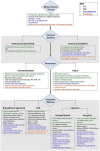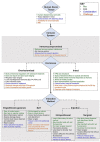Endometriosis in the Mouse: Challenges and Progress Toward a 'Best Fit' Murine Model
- PMID: 35095566
- PMCID: PMC8794744
- DOI: 10.3389/fphys.2021.806574
Endometriosis in the Mouse: Challenges and Progress Toward a 'Best Fit' Murine Model
Abstract
Endometriosis is a prevalent gynecologic condition associated with pelvic pain and infertility characterized by the implantation and growth of endometrial tissue displaced into the pelvis via retrograde menstruation. The mouse is a molecularly well-annotated and cost-efficient species for modeling human disease in the therapeutic discovery pipeline. However, as a non-menstrual species with a closed tubo-ovarian junction, the mouse poses inherent challenges as a preclinical model for endometriosis research. Over the past three decades, numerous murine models of endometriosis have been described with varying degrees of fidelity in recapitulating the essential pathophysiologic features of the human disease. We conducted a search of the peer-reviewed literature to identify publications describing preclinical research using a murine model of endometriosis. Each model was reviewed according to a panel of ideal model parameters founded on the current understanding of endometriosis pathophysiology. Evaluated parameters included method of transplantation, cycle phase and type of tissue transplanted, recipient immune/ovarian status, iterative schedule of transplantation, and option for longitudinal lesion assessment. Though challenges remain, more recent models have incorporated innovative technical approaches such as in vivo fluorescence imaging and novel hormonal preparations to overcome the unique challenges posed by murine anatomy and physiology. These models offer significant advantages in lesion development and readout toward a high-fidelity mouse model for translational research in endometriosis.
Keywords: endometriosis; lesions; mouse model; murine model; preclincal.
Copyright © 2022 Burns, Pearson, Slack, Por, Scribner, Eti and Burney.
Conflict of interest statement
The authors declare that the research was conducted in the absence of any commercial or financial relationships that could be construed as a potential conflict of interest.
Figures


Similar articles
-
Differences in growth and vascularization of ectopic menstrual and non-menstrual endometrial tissue in mouse models of endometriosis.Hum Reprod. 2021 Jul 19;36(8):2202-2214. doi: 10.1093/humrep/deab139. Hum Reprod. 2021. PMID: 34109385
-
Endometrial cells contribute to preexisting endometriosis lesions in a mouse model of retrograde menstruation†.Biol Reprod. 2019 Jun 1;100(6):1453-1460. doi: 10.1093/biolre/ioz039. Biol Reprod. 2019. PMID: 30869747 Free PMC article.
-
Mimicking Sampson's Retrograde Menstrual Theory in Rats: A New Rat Model for Ongoing Endometriosis-Associated Pain.Int J Mol Sci. 2020 Mar 27;21(7):2326. doi: 10.3390/ijms21072326. Int J Mol Sci. 2020. PMID: 32230898 Free PMC article.
-
Endometriosis: etiology and pathophysiology of infertility.Clin Obstet Gynecol. 1988 Dec;31(4):801-12. doi: 10.1097/00003081-198812000-00006. Clin Obstet Gynecol. 1988. PMID: 3067928 Review.
-
Biomarker development in endometriosis.Scand J Clin Lab Invest Suppl. 2014;244:75-81; discussion 80. doi: 10.3109/00365513.2014.936692. Scand J Clin Lab Invest Suppl. 2014. PMID: 25083898 Review.
Cited by
-
Advances in Vascular Diagnostics using Magnetic Particle Imaging (MPI) for Blood Circulation Assessment.Adv Healthc Mater. 2024 Sep;13(23):e2400612. doi: 10.1002/adhm.202400612. Epub 2024 Jun 28. Adv Healthc Mater. 2024. PMID: 38879782 Review.
-
D-chiro-inositol effectively counteracts endometriosis in a mouse model.Mol Med. 2025 Apr 11;31(1):134. doi: 10.1186/s10020-025-01178-6. Mol Med. 2025. PMID: 40211112 Free PMC article.
-
A novel nude mouse model for studying the pathogenesis of endometriosis.Exp Ther Med. 2022 Jun 8;24(2):498. doi: 10.3892/etm.2022.11425. eCollection 2022 Aug. Exp Ther Med. 2022. PMID: 35837067 Free PMC article.
-
The Known, the Unknown and the Future of the Pathophysiology of Endometriosis.Int J Mol Sci. 2024 May 27;25(11):5815. doi: 10.3390/ijms25115815. Int J Mol Sci. 2024. PMID: 38892003 Free PMC article. Review.
-
Estetrol Inhibits Endometriosis Development in an In Vivo Murine Model.Biomolecules. 2024 May 15;14(5):580. doi: 10.3390/biom14050580. Biomolecules. 2024. PMID: 38785987 Free PMC article.
References
-
- Alali Z., Graham A., Swan K., Flyckt R., Falcone T., Cui W., et al. (2020). 60S acidic ribosomal protein P1 (RPLP1) is elevated in human endometriotic tissue and in a murine model of endometriosis and is essential for endometriotic epithelial cell survival in vitro. Mol. Hum. Reprod. 26 53–64. 10.1093/molehr/gaz065 - DOI - PMC - PubMed
-
- Bacci M., Capobianco A., Monno A., Cottone L., Di Puppo F., Camisa B., et al. (2009). Macrophages are alternatively activated in patients with endometriosis and required for growth and vascularization of lesions in a mouse model of disease. Am. J. Pathol. 175 547–556. 10.2353/ajpath.2009.081011 - DOI - PMC - PubMed
Publication types
Grants and funding
LinkOut - more resources
Full Text Sources
Miscellaneous

